Spatiotemporal Dynamics and Driving Factors of Ecological Environment in Metropolitan Area Under Urban Spatial Structural Transformation
Abstract
1. Introduction
2. Materials and Methods
2.1. Study Area
2.2. Data Source
| Indicator | Spatial Resolution | Temporal Resolution | Source |
|---|---|---|---|
| Enhanced vegetation index (EVI) | 250 m | 16 day | NASA a (MOD13Q1) |
| Land surface temperature (LST) | 1000 m | 8 day | NASA a (MOD11A2) |
| Wetness (WET) | 1000 m | 8 day | NASA a (MOD09A1) |
| Normalized difference build-up and soil index (NDBSI) | 1000 m | 8 day | NASA a (MOD09A1) |
| Difference index (DI) | 1000 m | 8 day | NASA a (MOD09A1) |
| Evapotranspiration (ET) | 500 m | yearly | NASA a (MOD16A2GF) |
| Nighttime Light (NTL) | 500 m | yearly | HDV b |
| Population Density (PD) | 100 m | yearly | WorldPop |
| Precipitation (Pre) | 1000 m | monthly | TPDC c |
| Minimum Temperature (TEM) | 1000 m | monthly | TPDC c |
| Wind Speed (WS) | - | daily | NOAA d |
| Elevation (DEM) | 30 m | - | NASA a |
| Surface Roughness (SR) | 30 m | - | NASA a |
2.3. Methods
2.3.1. IRSEI Model
2.3.2. Local Moran’s I
2.3.3. Redundancy Analysis
3. Results
3.1. Spatial Pattern and Dynamics of IRSEI
3.2. LISA Cluster Character of IRSEI
3.3. Natural-Economic-Social Factors of IRSEI
4. Discussion
4.1. Analysis of the Spatiotemporal Pattern and Dynamics of EEQ
4.2. Driving Mechanism of EEQ
4.3. Complexity of EEQ
5. Conclusions
Supplementary Materials
Author Contributions
Funding
Institutional Review Board Statement
Informed Consent Statement
Data Availability Statement
Acknowledgments
Conflicts of Interest
Abbreviations
| CSR | Central Sixth Ring area |
| DEM | Elevation |
| EEQ | Ecological Environment Quality |
| ET | Evapotranspiration |
| LISA | Local Moran’s I |
| InVEST | Integrated Valuation of Ecosystem Services and Tradeoffs |
| IRSEI | Improved Remote Sensing Ecological Index |
| NTL | Nighttime Lighting Index |
| NEM | Northeast Mountain area |
| NWM | Northwest Mountain area |
| PD | Population density |
| PLA | Plain Land area |
| Pre | Precipitation |
| PSR | Pressure–State–Response |
| RDA | Redundancy Analysis |
| RSEI | Remote Sensing Ecological Index |
| SR | Surface Roughness |
| SWM | Southwest Mountain area |
| TEM | Minimum Temperature |
| WS | Wind Speed |
References
- Azurza-Zubizarreta, O.; Basurko-PerezdeArenaza, I.; Zelarain, E.; Villamor, E.; Akizu-Gardoki, O.; Villena-Camarero, U.; Campos-Celador, A.; Barcena-Hinojal, I. Urban Energy Transitions in Europe, towards Low-Socio-Environmental Impact Cities. Sustainability 2021, 13, 11641. [Google Scholar] [CrossRef]
- Fastenrath, S.; Braun, B. Lost in Transition? Directions for an Economic Geography of Urban Sustainability Transitions. Sustainability 2018, 10, 2434. [Google Scholar] [CrossRef]
- Kołsut, B.; Kudłak, R. From systemic to sustainability transitions: An emerging economy perspective on urban sprawl and the automobile revolution. Eur. Urban Reg. Stud. 2023, 31, 149–167. [Google Scholar] [CrossRef]
- United Nations. World Urbanization Prospects 2018: Highlights. United Nations, Department of Economic and Social Affairs, Population Division. 2018. Available online: https://population.un.org/wup/assets/WUP2018-Highlights.pdf (accessed on 20 September 2020).
- Laurance, W.F.; Engert, J. Sprawling cities are rapidly encroaching on Earth’s biodiversity. Proc. Natl. Acad. Sci. USA 2022, 119, e2202244119. [Google Scholar] [CrossRef]
- Marley, H.G.; Dirks, K.N.; Neverman, A.J.; McKendry, I.; Salmond, J.A. The Relationship Between Brown Haze, Atmospheric Boundary Layer Structure, and Air Pollution in an Urban Area of Complex Coastal Terrain. Atmosphere 2021, 12, 101057. [Google Scholar] [CrossRef]
- Middleton, N.; Kang, U. Sand and Dust Storms: Impact Mitigation. Sustainability 2017, 9, 1053. [Google Scholar] [CrossRef]
- Thackeray, C.W.; Hall, A.; Norris, J.; Chen, D. Constraining the increased frequency of global precipitation extremes under warming. Nat. Clim. Change 2022, 12, 441–448. [Google Scholar] [CrossRef]
- Tuel, A.; Steinfeld, D.; Ali, S.M.; Sprenger, M.; Martius, O. Large-Scale Drivers of Persistent Extreme Weather During Early Summer 2021 in Europe. Geophys. Res. Lett. 2022, 49, e2022GL099624. [Google Scholar] [CrossRef]
- Silva, R.M.D.; Santos, C.A.G.; de Araujo Maranhao, K.U.; Silva, A.M.; de Lima, V.R.P. Geospatial assessment of eco-environmental changes in desertification area of the Brazilian semi-arid region/Evaluación geoespacial de los cambios ecoambientales en el área de desertificación de la región semiárida brasileña. Earth Sci. Res. J. 2018, 22, 175. [Google Scholar] [CrossRef]
- Paetzold, A.; Warren, P.H.; Maltby, L.L. A Framework for Assessing Ecological Quality Based on Ecosystem Services. Ecol. Complex. 2010, 7, 273–281. [Google Scholar] [CrossRef]
- Hunter, A.J.; Luck, G.W. Defining and Measuring the Social-Ecological Quality of Urban Greenspace: A Semi-Systematic Review. Urban. Ecosyst. 2015, 18, 1139–1163. [Google Scholar] [CrossRef]
- Mahaut, L.; Choler, P.; Denelle, P.; Garnier, É.; Thuiller, W.; Kattge, J.; Lemauviel-Lavenant, S.; Lavorel, S.; Munoz, F.; Renard, D.; et al. Trade-Offs and Synergies between Ecosystem Productivity and Stability in Temperate Grasslands. Glob. Ecol. Biogeogr. 2023, 32, 561–572. [Google Scholar] [CrossRef]
- Kutty, A.A.; Kucukvar, M.; Onat, N.C.; Ayvaz, B.; Abdella, G.M. Measuring Sustainability, Resilience and Livability Performance of European Smart Cities: A Novel Fuzzy Expert-Based Multi-Criteria Decision Support Model. Cities 2023, 137, 104293. [Google Scholar] [CrossRef]
- Sahana, M.; Saini, M.; Areendran, G.; Imdad, K.; Sarma, K.; Sajjad, H. Assessing Wetland Ecosystem Health in Sundarban Biosphere Reserve Using Pressure-State-Response Model and Geospatial Techniques. Remote Sens. Appl. Soc. Environ. 2022, 26, 100754. [Google Scholar] [CrossRef]
- Corridore, M.; de Jesús Crespo, R.; Valladares-Castellanos, M.; Douthat, T. From the Mountains to the Beach: Water Purification Ecosystem Services and Recreational Beach Use in Puerto Rico. Sustainability 2025, 17, 2556. [Google Scholar] [CrossRef]
- Xu, H. Creation and application of urban remote sensing ecological index. Acta Ecol. Sin. 2013, 33, 7853–7862. [Google Scholar]
- Tang, Q.; Hua, L.; Tang, J.; Jiang, L.; Wang, Q.; Cao, Y.; Wang, T.; Cai, C. Advancing ecological quality assessment in China: Introducing the ARSEI and identifying key regional drivers. Ecol. Indic. 2024, 163, 112109. [Google Scholar] [CrossRef]
- Zhao, C.; Cao, X.; Chen, X.; Cui, X. A consistent and corrected nighttime light dataset (CCNL 1992–2013) from DMSP-OLS data. Sci. Data 2022, 9, 424. [Google Scholar] [CrossRef]
- Gong, C.; Lyu, F.; Wang, Y. Spatiotemporal change and drivers of ecosystem quality in the Loess Plateau based on RSEI: A case study of Shanxi, China. Ecol. Indic. 2023, 155, 111060. [Google Scholar] [CrossRef]
- Zhang, X.; Fan, H.; Sun, L.; Liu, W.; Wang, C.; Wu, Z.; Lv, T. Identifying regional eco-environment quality and its influencing factors: A case study of an ecological civilization pilot zone in China. J. Clean. Prod. 2024, 435, 140308. [Google Scholar] [CrossRef]
- Xin, J.; Yang, J.; Yu, H.; Ren, J.; Yu, W.; Cong, N.; Xiao, X.; Xia, J.; Li, X.; Qiao, Z. Towards ecological civilization: Spatiotemporal heterogeneity and drivers of ecological quality transitions in China (2001–2020). Appl. Geogr. 2024, 173, 103439. [Google Scholar] [CrossRef]
- Qin, G.; Wang, N.; Wu, Y.; Zhang, Z.; Meng, Z.; Zhang, Y. Spatiotemporal variations in eco-environmental quality and responses to drought and human activities in the middle reaches of the Yellow River basin, China from 1990 to 2022. Ecol. Inform. 2024, 81, 102641. [Google Scholar] [CrossRef]
- Du, Z.; Ji, X.; Zhao, W.; Jiang, J.; He, Z.; Liu, H.; Gao, J.; Wang, X. Integrating revised DPSIR and ecological security patterns to assess the health of alpine grassland ecosystems on the Qinghai-Tibet Plateau. Sci. Total Environ. 2024, 957, 177833. [Google Scholar] [CrossRef]
- Zhang, X.; Fan, H.; Liu, F.; Lv, T.; Sun, L.; Li, Z.; Shang, W.; Xu, G. Coupling coordination between the ecological environment and urbanization in the middle reaches of the Yangtze River urban agglomeration. Urban Clim. 2023, 52, 101698. [Google Scholar] [CrossRef]
- Cao, J.; Wu, E.; Wu, S.; Fan, R.; Xu, L.; Ning, K.; Li, Y.; Lu, R.; Xu, X.; Zhang, J.; et al. Spatiotemporal Dynamics of Ecological Condition in Qinghai-Tibet Plateau Based on Remotely Sensed Ecological Index. Remote Sens. 2022, 14, 4234. [Google Scholar] [CrossRef]
- Wang, Z.; Fu, B.; Wu, X.; Li, Y.; Feng, Y.; Wang, S.; Wei, F.; Zhang, L. Vegetation resilience does not increase consistently with greening in China’s Loess Plateau. Commun. Earth Environ. 2023, 4, 336. [Google Scholar] [CrossRef]
- Luque-García, L.; Bataineh, S.; Al-Bakri, J.; Abdulla, F.A.; Al-Delaimy, W.K. The heat-mortality association in Jordan: Effect modification by greenness, population density and urbanization level. Sci. Total Environ. 2024, 952, 176010. [Google Scholar] [CrossRef]
- Yuan, B.; Fu, L.; Zou, Y.; Zhang, S.; Chen, X.; Li, F.; Deng, Z.; Xie, Y. Spatiotemporal change detection of ecological quality and the associated affecting factors in Dongting Lake Basin, based on RSEI. J. Clean. Prod. 2021, 302, 126995. [Google Scholar] [CrossRef]
- Lei, X.; Liu, H.; Li, S.; Luo, Q.; Cheng, S.; Hu, G.; Wang, X.; Bai, W. Coupling coordination analysis of urbanization and ecological environment in Chengdu-Chongqing urban agglomeration. Ecol. Indic. 2024, 161, 111969. [Google Scholar] [CrossRef]
- Dong, X.; Xu, K.; Li, W.; Tian, Q.; Fan, Q.; Fang, S.; Shen, J.; Jia, M.; Tian, J. Spatiotemporal evolution and influencing mechanism of urbanization and ecological environmental quality between 2000 and 2020 in Henan Province, China. Remote Sens. Appl. Soc. Environ. 2025, 37, 101492. [Google Scholar] [CrossRef]
- Cai, B.; Shao, Z.; Fang, S.; Huang, X.; Huq, M.E.; Tang, Y.; Li, Y.; Zhuang, Q. Finer-scale spatiotemporal coupling coordination model between socioeconomic activity and eco-environment: A case study of Beijing, China. Ecol. Indic. 2021, 131, 108165. [Google Scholar] [CrossRef]
- Tan, F.; Cheng, Y.; Yuan, Y.; Wang, X.; Fan, B. Comprehensive comparison of two models evaluating eco-environmental quality in Fangshan. Heliyon 2024, 10, e29295. [Google Scholar] [CrossRef]
- Yao, J.; Mo, F.; Zhai, H.; Sun, S.; Feger, K.-H.; Zhang, L.; Tang, X.; Li, G.; Zhu, H. A spatio-temporal prediction model theory based on deep learning to evaluate the ecological changes of the largest reservoir in North China from 1985 to 2021. Ecol. Indic. 2022, 145, 109618. [Google Scholar] [CrossRef]
- Li, Y.; Wu, L.; Han, Q.; Wang, X.; Zou, T.; Fan, C. Estimation of remote sensing based ecological index along the Grand Canal based on PCA-AHP-TOPSIS methodology. Ecol. Indic. 2021, 122, 107214. [Google Scholar] [CrossRef]
- Zhang, N.; Zhang, J.; Chen, W.; Su, J. Block-based variations in the impact of characteristics of urban functional zones on the urban heat island effect: A case study of Beijing. Sustain. Cities Soc. 2022, 76, 103529. [Google Scholar] [CrossRef]
- WorldPop and Center for International Earth Science Information Network, Columbia University. Global High Resolution Population Denominators Project. 2018. Available online: https://hub.worldpop.org/geodata/listing?id=29 (accessed on 15 January 2025). [CrossRef]
- Chen, Z.; Yu, B.; Yang, C.; Zhou, Y.; Yao, S.; Qian, X.; Wang, C.; Bin, W.; Wu, J. An Extended Time-Series (2000–2023) of Global NPP-VIIRS-like Nighttime Light Data; Harvard Dataverse: Fuzhou, China, 2020. [Google Scholar] [CrossRef]
- Peng, S. 1-km Monthly Precipitation Dataset for CHINA (1901–2023); National Tibetan Plateau/Third Pole Environment Data Center: Beijing, China, 2020. [Google Scholar] [CrossRef]
- Peng, S. 1-km Monthly Minimum Temperature Dataset for China (1901–2023); National Tibetan Plateau/Third Pole Environment Data Center: Beijing, China, 2020. [Google Scholar] [CrossRef]
- National Aeronautics and Space Administration. Available online: https://www.nasa.gov (accessed on 25 October 2024).
- National Oceanic and Atmospheric Administration. Available online: https://www.noaa.gov (accessed on 2 January 2025).
- Anselin, L. Local Indicators of Spatial Association—LISA. Geogr. Anal. 1995, 27, 93–115. [Google Scholar] [CrossRef]
- Capblancq, T.; Forester, B.R. Redundancy Analysis: A Swiss Army Knife for Landscape Genomics. Methods Ecol. Evol. 2021, 12, 2298–2309. [Google Scholar] [CrossRef]
- Zhu, H.; Xu, Q.; Zheng, Y.; Cui, J.; Meng, Q. Ecological health assessment of the middle route of the South-to-North Water Diversion Project using an enhanced VORS model. Ecol. Indic. 2025, 172, 113281. [Google Scholar] [CrossRef]
- Chiam, Z.; Song, X.P.; Lai, H.R.; Tan, H.T.W. Particulate matter mitigation via plants: Understanding complex relationships with leaf traits. Sci. Total Environ. 2019, 688, 398–408. [Google Scholar] [CrossRef]
- Mancini, M.C.; Collins, R.M.; Addicott, E.T.; Balmford, B.J.; Binner, A.; Bull, J.W.; Day, B.H.; Eigenbrod, F.; zu Ermgassen, S.O.; Faccioli, M.; et al. Biodiversity offsets perform poorly for both people and nature, but better approaches are available. One Earth 2024, 7, 2165–2174. [Google Scholar] [CrossRef]
- Pramanik, M.; Kumar, A.; Paramanik, S. Urban Green Infrastructure Planning for the Bangkok Metropolitan Region: An Empirical Study for Greenspace Expansion; Qeios: London, UK, 2024. [Google Scholar] [CrossRef]
- Meng, R.; Meng, Z.; Li, H.; Cai, J.; Qin, L. Changes in landscape ecological risk in the Beijing-Tianjin Sandstorm source control project area from a spatiotemporal perspective. Ecol. Indic. 2024, 167, 112569. [Google Scholar] [CrossRef]
- Liu, Y.; Dang, C.; Yue, H.; Lü, C.; Qian, J.; Zhu, R. Comparative Analysis of the Improved Remote Sensing Ecological Index and RSEI. J. Remote Sens. 2022, 26, 683–697. [Google Scholar]
- Chen, J.; Huang, X.; Shao, Z.; Zheng, X.; Cai, B. Global Inequality of PM2.5 Exposure and Ecological Possession over 2001–2020. J. Remote Sens. 2025, 5, 0446. [Google Scholar] [CrossRef]
- Beijing Municipal Commision of Development and Reform People’s Government. The 11th Five-Year Plan for Environmental Protection and Ecological Construction in Beijing. Beijing Municipal Commision of Development and Reform People’s Government. 2006. Available online: https://fgw.beijing.gov.cn/fgwzwgk/2024zcwj/ghjhwb/wngh/202003/t20200331_3739254.htm (accessed on 17 November 2024).
- Wang, Z.; Zhao, X.; Cui, L.; Lei, Y.; Guo, Z.; Wang, J.; Li, J.; Zhai, X.; Wang, R.; Li, W. Identification and optimization of urban wetland ecological networks in highly urbanized areas: A case study of Haidian District, Beijing. Ecol. Indic. 2025, 170, 113028. [Google Scholar] [CrossRef]
- Jing, X.; Lun, X.; Fan, C.; Ma, W. Emission patterns of biogenic volatile organic compounds from dominant forest species in Beijing, China. J. Environ. Sci 2020, 95, 73–81. [Google Scholar] [CrossRef]
- Foyde, B.; Lu, Z.; Streets, D.G. Satellite NO2 retrievals suggest China has exceeded its NOx reduction goals from the twelfth Five-Year Plan. Sci. Rep. 2016, 6, 35912. [Google Scholar] [CrossRef]
- Liu, T.; Wang, L.; Zhou, P.; Li, H. How does China’s Winter Heating policy impact corporate sustainable development performance? Energy 2024, 313, 133771. [Google Scholar] [CrossRef]
- Xu, J.; Zhang, Z.; Zhao, X.; Cheng, S. Downward trend of NO2 in the urban areas of Beijing-Tianjin-Hebei region from 2014 to 2020: Comparison of satellite retrievals, ground observations, and emission inventories. Atmos. Environ. 2023, 295, 119531. [Google Scholar] [CrossRef]
- Hoeltgebaum, L.E.B.; Dias, N.L. Evaluation of the storage and evapotranspiration terms of the water budget for an agricultural watershed using local and remote-sensing measurements. Agric. For. Meteorol. 2023, 341, 109615. [Google Scholar] [CrossRef]
- Ye, P.; Zhang, Q.; Wang, J.; Liu, X.; Wei, D.; Liu, W.; Li, Y.; Huang, X.; Gan, Z. Interdecadal shifts and associated atmospheric circulation anomalies of heavy precipitation during the warm-season in the Upper Yellow River Basin over the past 40 years. Atmos. Res. 2025, 314, 109615. [Google Scholar] [CrossRef]
- Cao, J.; Adamowski, J.F.; Deo, R.C.; Xu, X.; Gong, Y.; Feng, Q. Grassland Degradation on the Qinghai-Tibetan Plateau: Reevaluation of Causative Factors. Rangel. Ecol. Manag. 2019, 72, 988–995. [Google Scholar] [CrossRef]
- Schymanski, S.J.; Or, D. Wind Increases Leaf Water Use Efficiency. Plant Cell Environ. 2016, 39, 1448–1459. [Google Scholar] [CrossRef] [PubMed]
- Bastiaansen, R.; Carter, P.; Doelman, A. Stable Planar Vegetation Stripe Patterns on Sloped Terrain in Dryland Ecosystems. arXiv 2018, arXiv:1811.10226. [Google Scholar] [CrossRef]
- La Pierre, K.J.; Blumenthal, D.M.; Brown, C.S.; Klein, J.A.; Smith, M.D. Drivers of Variation in Aboveground Net Primary Productivity and Plant Community Composition Differ across a Broad Precipitation Gradient. Ecosystems 2016, 19, 521–534. [Google Scholar] [CrossRef]
- Tal, A. The Environmental Impacts of Overpopulation. Encyclopedia 2025, 5, 45. [Google Scholar] [CrossRef]
- Ekeocha, D. O. Urbanization, inequality, economic development and ecological footprint: Searching for turning points and regional homogeneity in Africa. J. Clean. Prod. 2021, 286, 125244. [Google Scholar] [CrossRef]
- Tian, Y.; Tsendbazar, N.-E.; van Leeuwen, E.; Fensholt, R.; Herold, M. A Global Analysis of Multifaceted Urbanization Patterns Using Earth Observation Data from 1975 to 2015. Landsc. Urban Plan. 2022, 219, 104316. [Google Scholar] [CrossRef]
- Aulsebrook, A.E.; Lesku, J.A.; Mulder, R.A.; Goymann, W.; Vyssotski, A.L.; Jones, T.M. Streetlights Disrupt Night-Time Sleep in Urban Black Swans. Front. Ecol. Evol. 2020, 8, 131. [Google Scholar] [CrossRef]
- Ahmad, N.; Du, L.; Lu, J.; Wang, J.; Li, H.-Z.; Hashmi, M.Z. Modelling the CO2 emissions and economic growth in Croatia: Is there any environmental Kuznets curve? Energy 2017, 123, 164–172. [Google Scholar] [CrossRef]
- Zeng, L.; Yang, L.; Su, L.; Hu, H.; Feng, C. The impact of policies on land use and land cover changes in the Beijing-Tianjin-Hebei region in China. Environ. Impact Assess. Rev. 2025, 110, 107676. [Google Scholar] [CrossRef]
- Zaki, A.; Buchori, I.; Pangi, P.; Sejati, A.W.; Liu, Y. Google Earth Engine for improved spatial planning in agricultural and forested lands: A method for projecting future ecological quality. Remote Sens. Appl. Soc. Environ. 2023, 32, 101078. [Google Scholar] [CrossRef]
- Beijing Transport Institute. Annual Report on Beijing Transportation Development 2021. Beijing Transport Institute. 2021. Available online: https://www.bjtrc.org.cn/List/index/cid/7.html (accessed on 15 January 2025).
- Walczykiewicz, T.; Skonieczna, M. Rainfall Flooding in Urban Areas in the Context of Geomorphological Aspects. Geosciences 2020, 10, 457. [Google Scholar] [CrossRef]
- Pei, Y.; Liu, J.; Wang, J.; Mei, C.; Dong, L.; Wang, H. Effects of urbanization on extreme precipitation based on Weather Research and Forecasting model: A case study of heavy rainfall in Beijing. J. Hydrol. Reg. Stud. 2024, 56, 102078. [Google Scholar] [CrossRef]
- Cojoc, L.; de Castro-Català, N.; de Guzmán, I.; González, J.; Arroita, M.; Besolí-Mestres, N.; Cadena, I.; Freixa, A.; Gutiérrez, O.; Larrañaga, A.; et al. Pollutants in Urban Runoff: Scientific Evidence on Toxicity and Impacts on Freshwater Ecosystems. Chemosphere 2024, 369, 143806. [Google Scholar] [CrossRef] [PubMed]
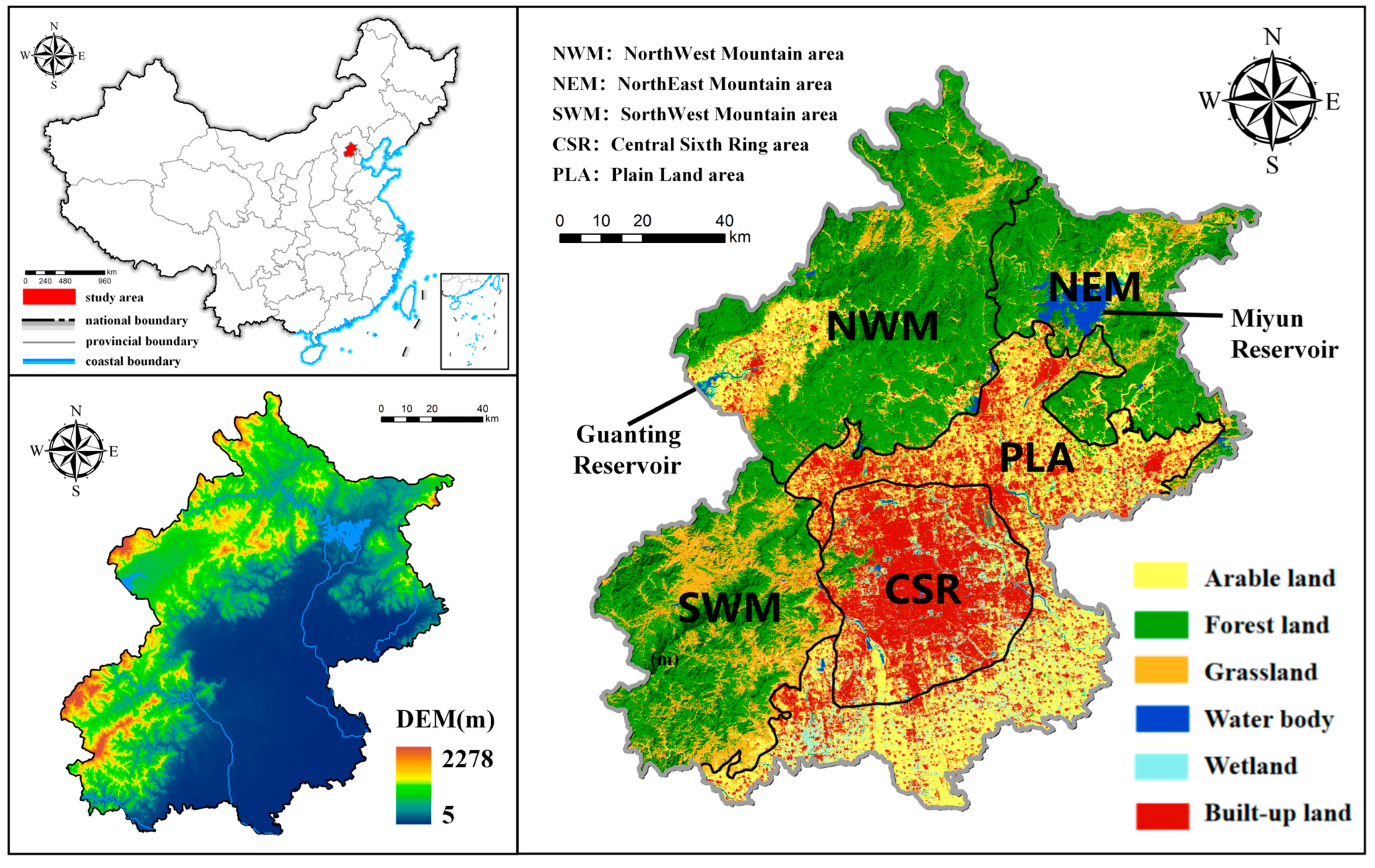
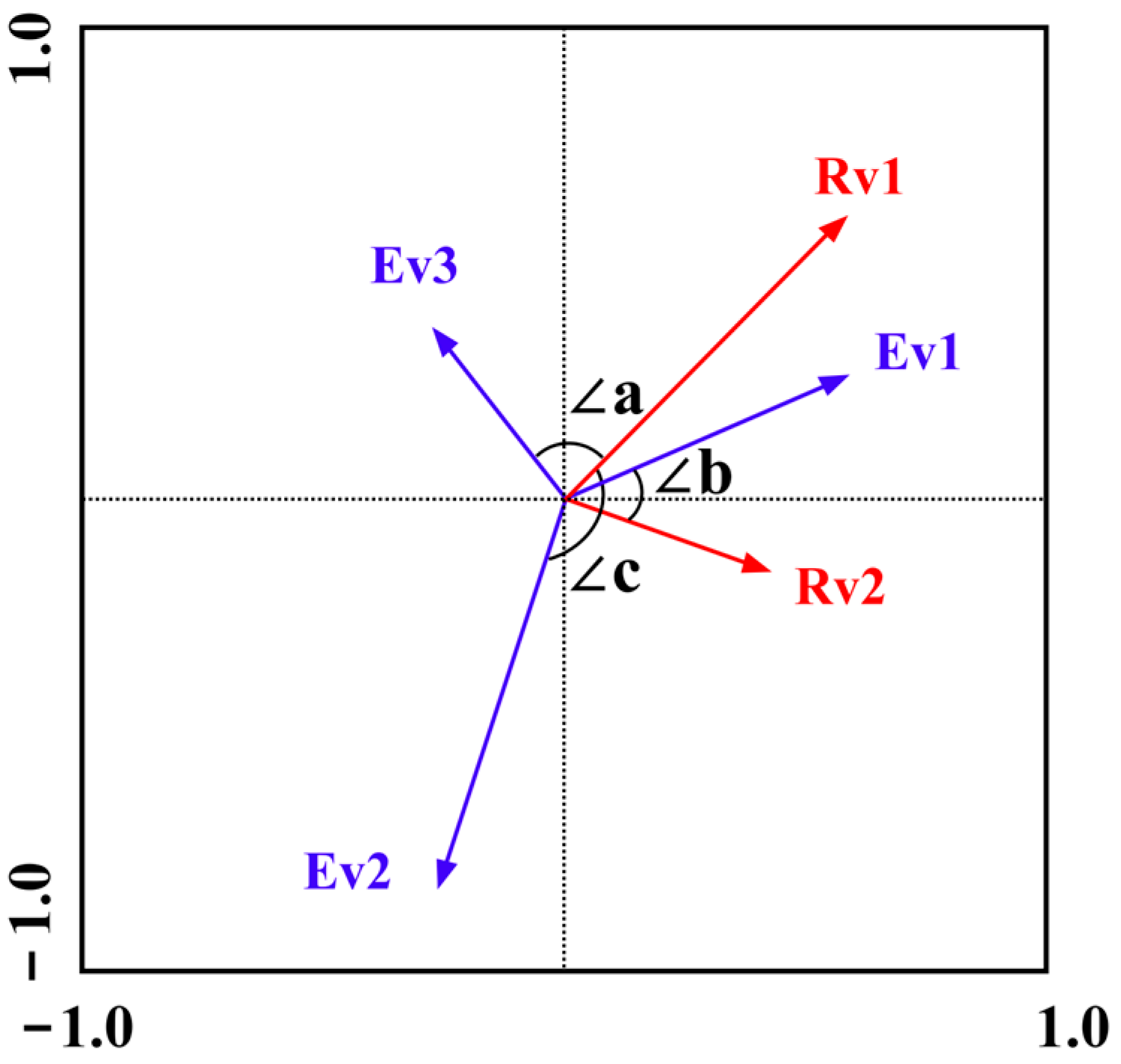
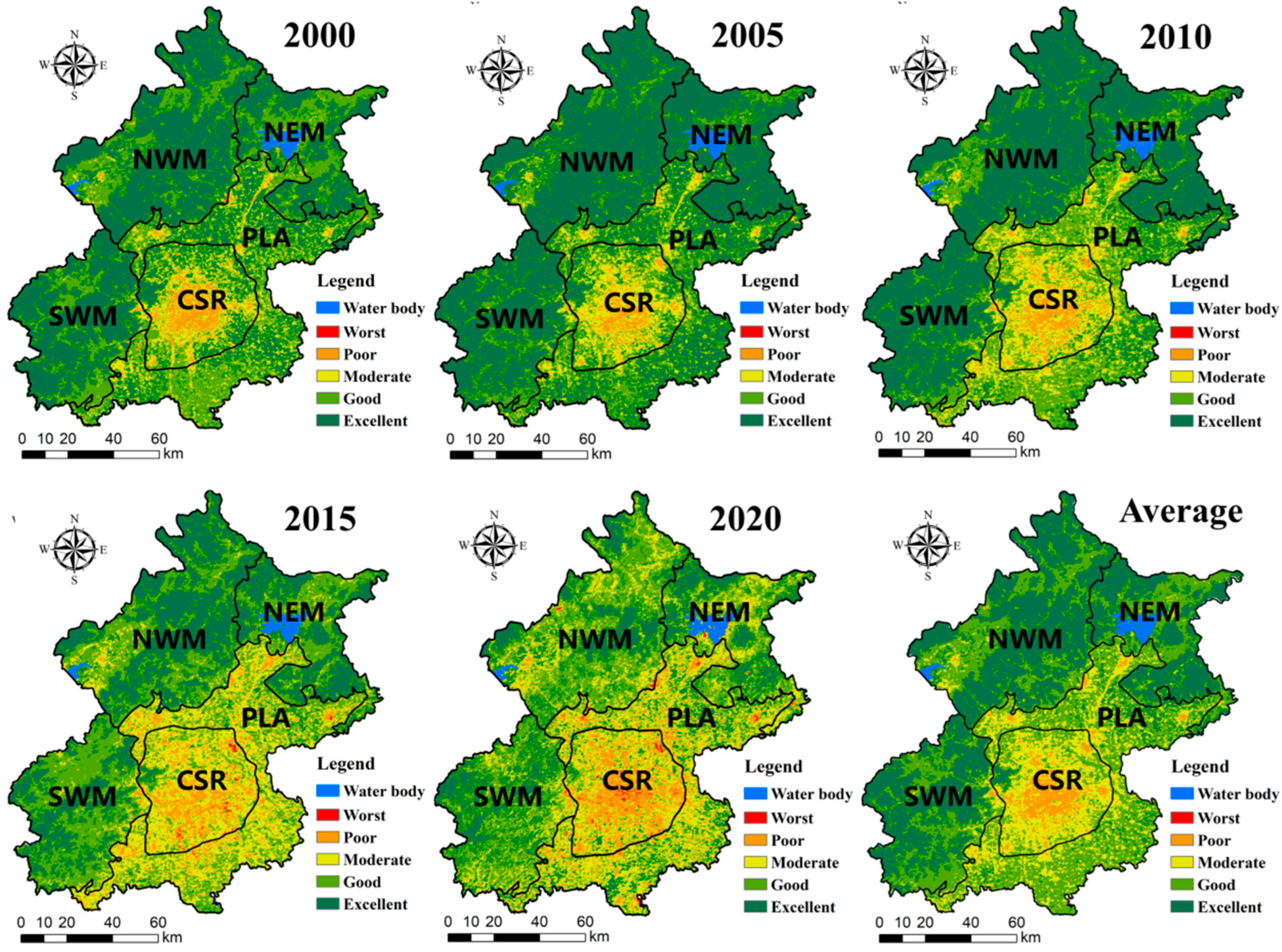
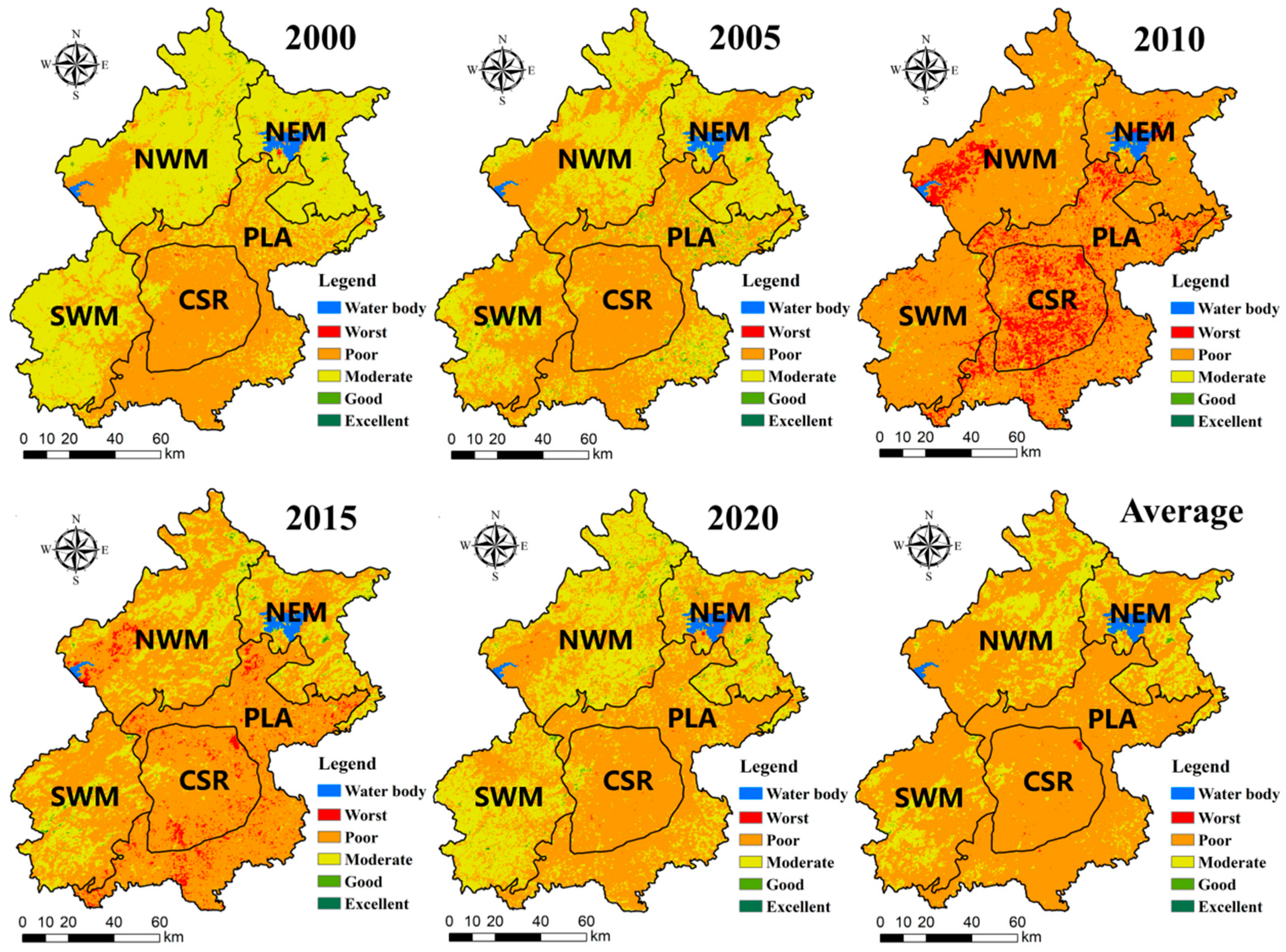
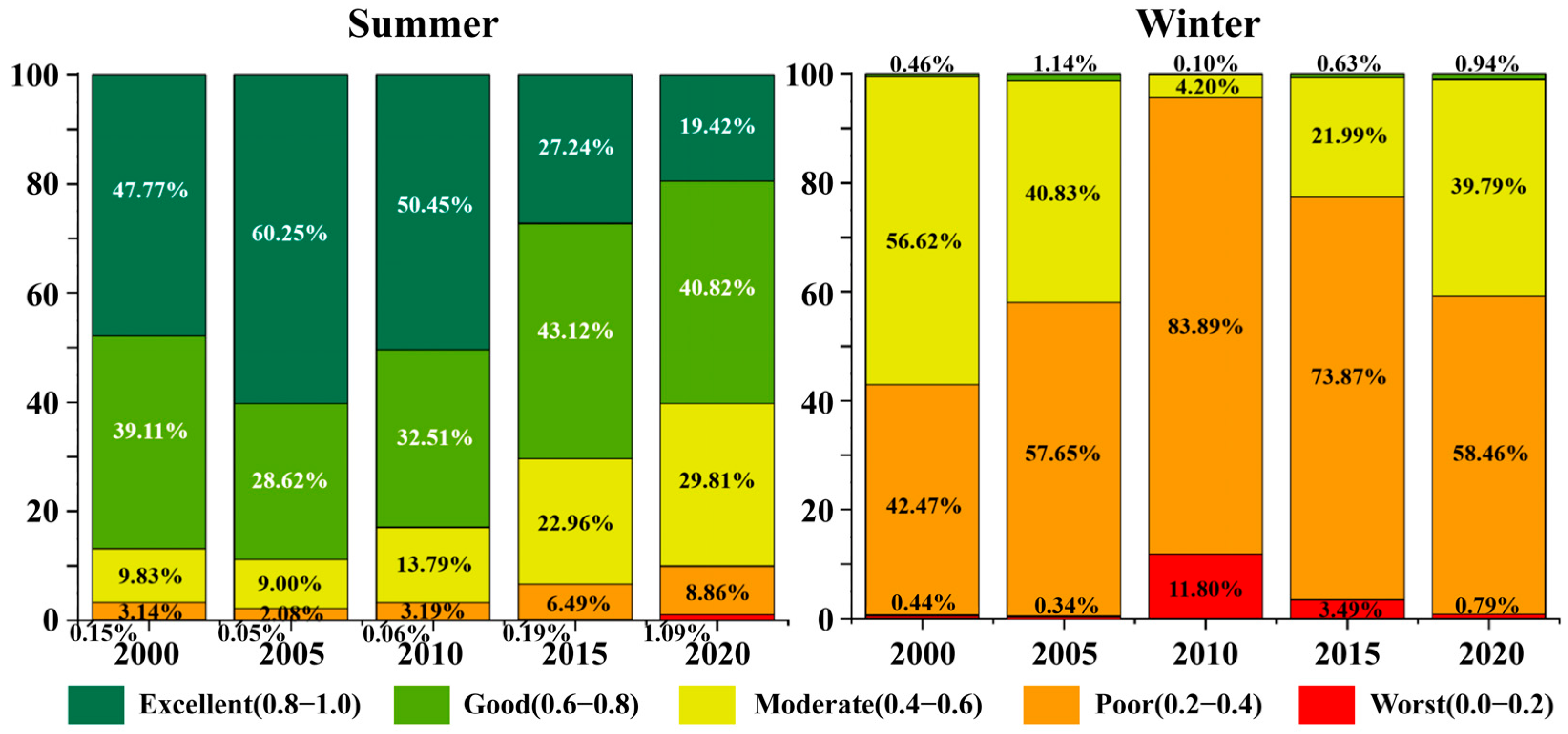
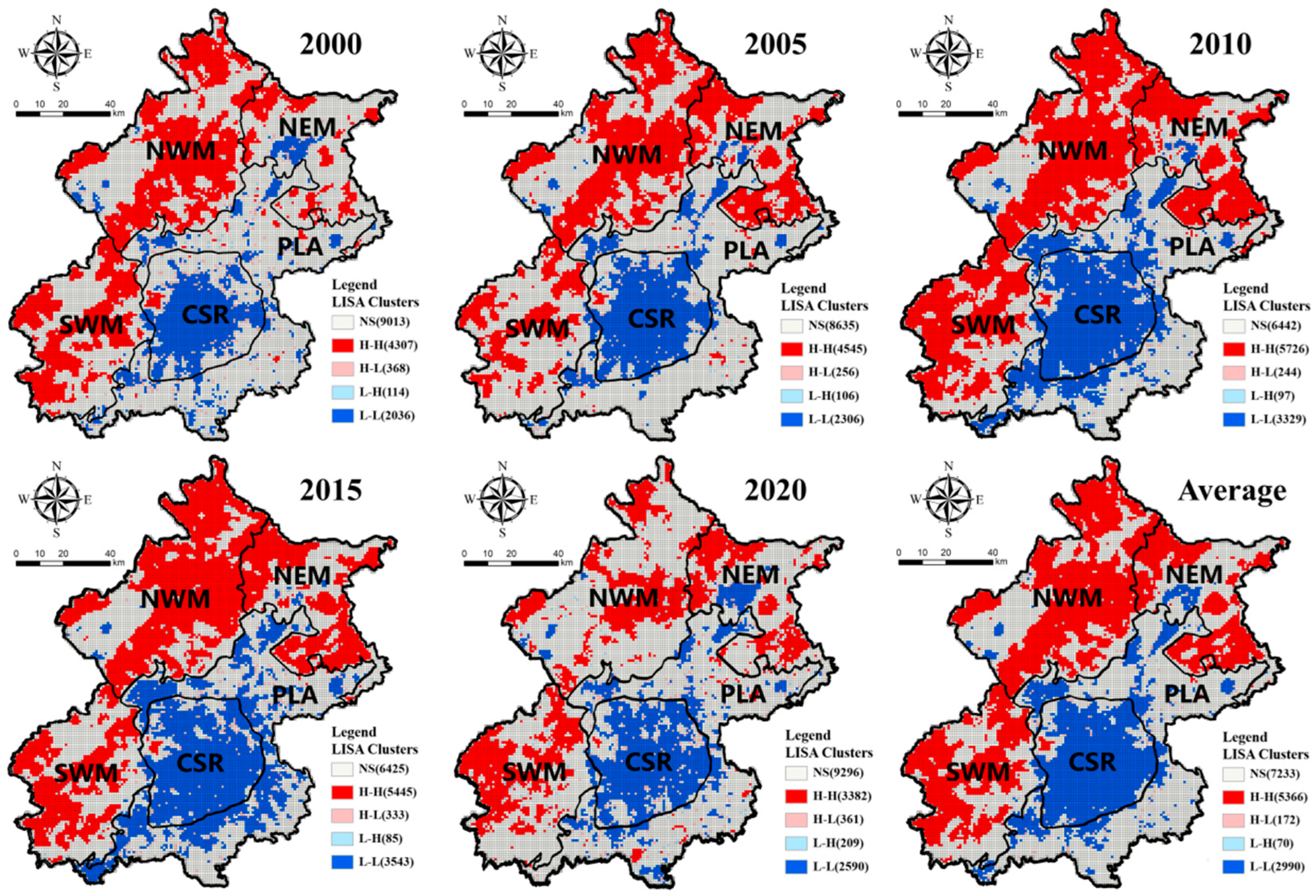
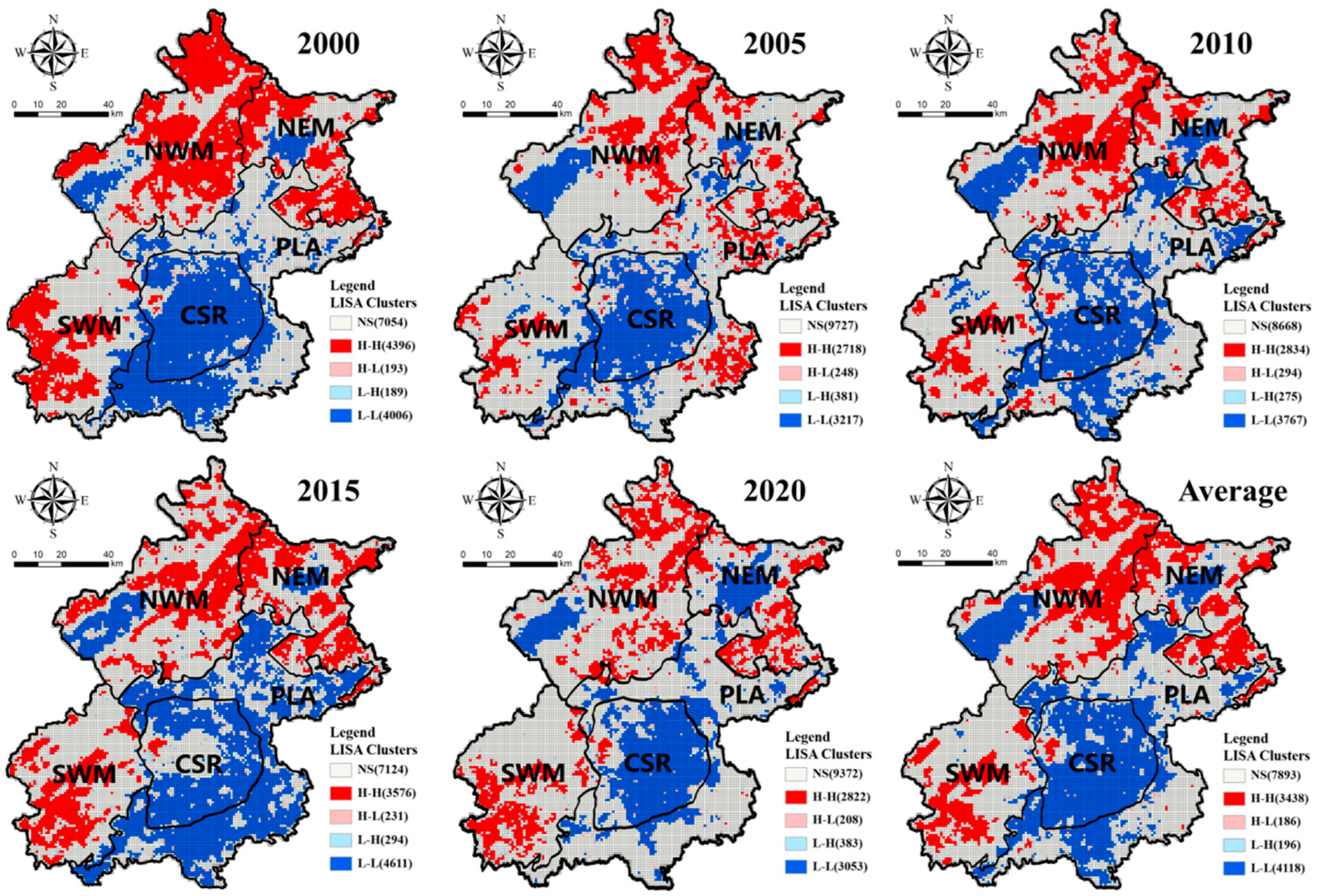
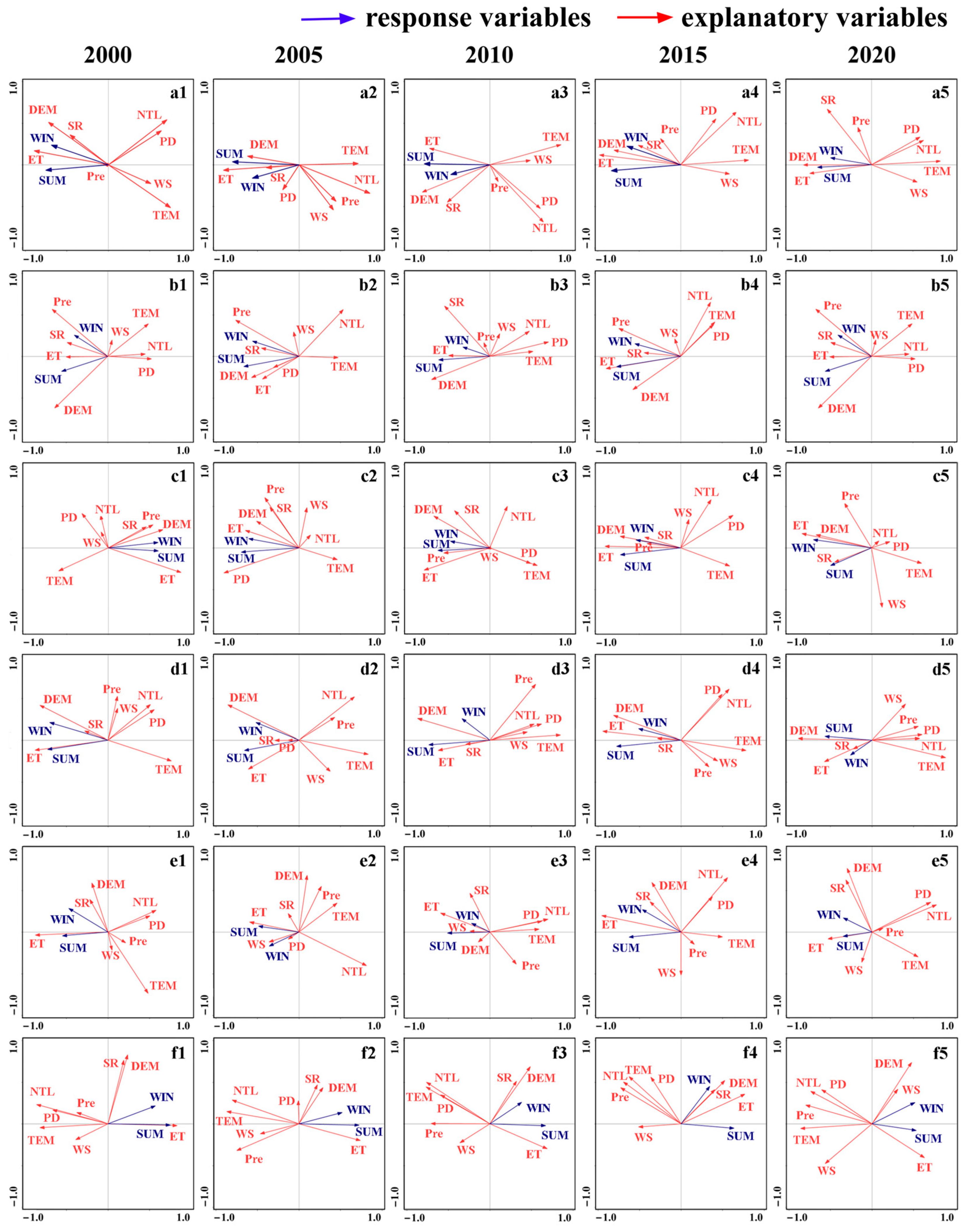
Disclaimer/Publisher’s Note: The statements, opinions and data contained in all publications are solely those of the individual author(s) and contributor(s) and not of MDPI and/or the editor(s). MDPI and/or the editor(s) disclaim responsibility for any injury to people or property resulting from any ideas, methods, instructions or products referred to in the content. |
© 2025 by the authors. Licensee MDPI, Basel, Switzerland. This article is an open access article distributed under the terms and conditions of the Creative Commons Attribution (CC BY) license (https://creativecommons.org/licenses/by/4.0/).
Share and Cite
Wang, J.; Wang, J.; Jia, J.; Li, G. Spatiotemporal Dynamics and Driving Factors of Ecological Environment in Metropolitan Area Under Urban Spatial Structural Transformation. Sustainability 2025, 17, 6056. https://doi.org/10.3390/su17136056
Wang J, Wang J, Jia J, Li G. Spatiotemporal Dynamics and Driving Factors of Ecological Environment in Metropolitan Area Under Urban Spatial Structural Transformation. Sustainability. 2025; 17(13):6056. https://doi.org/10.3390/su17136056
Chicago/Turabian StyleWang, Jingyi, Jinghan Wang, Jia Jia, and Guangyong Li. 2025. "Spatiotemporal Dynamics and Driving Factors of Ecological Environment in Metropolitan Area Under Urban Spatial Structural Transformation" Sustainability 17, no. 13: 6056. https://doi.org/10.3390/su17136056
APA StyleWang, J., Wang, J., Jia, J., & Li, G. (2025). Spatiotemporal Dynamics and Driving Factors of Ecological Environment in Metropolitan Area Under Urban Spatial Structural Transformation. Sustainability, 17(13), 6056. https://doi.org/10.3390/su17136056







